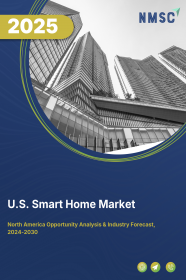
U.S. Smart Home Market by Product Type (Smart Lighting, Smart Home Security & Surveillance, Smart Entertainment, and Smart Appliances), by Communication Protocol (Wi-Fi, Zigbee, Z-Wave, Bluetooth, and Thread), by Smart Home Hubs (Standalone Hubs and Built-in Hubs), by Voice Assistants Integration (Amazon Alexa, Google Assistant, Apple Siri, and Others) – Opportunity Analysis and Industry Forecast, 2024–2030
Industry: Retail and Consumer | Publish Date: 15-Feb-2025 | No of Pages: 140 | No. of Tables: 104 | No. of Figures: 69 | Format: PDF | Report Code : RC2265
US Tariff Impact on U.S. Smart Home Market
Trump Tariffs Are Reshaping Global Business
U.S. Smart Home Market Overview
The U.S. Smart Home Market size was valued at USD 22.91 billion in 2023, and is predicted to reach USD 65.87 billion by 2030, at a CAGR of 16.3% from 2024 to 2030. A smart home alternatively referred to as a connected home, describes a dwelling outfitted with sophisticated technology and automated systems that facilitate the centralized management and surveillance of diverse household devices, appliances, and security features via a unified network.
These intelligent home assistant devices can be controlled remotely and frequently respond to voice commands or predetermined schedules, enhancing convenience, energy efficiency, and security for homeowners. Typical components of connected homes encompass smart thermostats, lighting systems, security cameras, voice assistants, and other interconnected devices tailored to enhance the overall residential lifestyle.
Digitalization and Energy Efficiency Initiatives Propels the Market Growth
The rapid advancement of digitalization, coupled with a robust emphasis on energy efficiency initiatives, serves as a driving force behind the expansion of the smart home market in the US. As consumers increasingly embrace connected home technologies to augment convenience and control in an increasingly digitally connected world, there is a simultaneous shift towards prioritizing energy efficiency and sustainability. This dual momentum encourages widespread adoption of smart thermostats, lighting systems, and appliances, empowering homeowners to curtail energy consumption and lower costs.
The synergy between digitalization and energy-consciousness propels the U.S. smart home market forward, as Americans actively seek innovative solutions to make their residences smarter and more eco-friendly.
Projections indicate steady growth in the U.S. smart home market over the next five years, with user penetration anticipated to reach 68.64% by 2027, reflecting a notable 20.7 percentage point increase from 2023.
High Disposable Income Drives the Growth of the Market
The U.S. smart home market growth is significantly fueled by the relatively affluent consumer base in the region. With considerable purchasing power at their disposal, American households exhibit a heightened inclination towards investing in premium home technologies and automation solutions, including connected home products.
Data from the US Bureau of Labor Statistics (BLS) reveals a substantial increase in disposable income among American households in 2022, with average annual expenditures reaching USD 72,967 million that is an impressive 9.0% surge from the previous year. As disposable income levels continue to rise, the demand for wireless home systems is expected to escalate further, solidifying their status as indispensable components of modern American households.
Security and Privacy Apprehensions Act as a Barrier to the Expansion of the Market
The advancement of the U.S. smart home industry encounters a notable challenge due to concerns surrounding the security of interconnected systems. Devices such as thermostats, cameras, and door locks are vulnerable to cyber intrusions, posing risks to residents' privacy and safety. This susceptibility often arises from weak passwords or insufficient security measures within Wi-Fi networks.
Cyber attackers exploit these vulnerabilities to gain unauthorized entry, potentially manipulating devices or accessing sensitive information. To address these concerns, homeowners utilizing smart technology must prioritize robust password protocols, routinely update device firmware, and fortify their home networks to diminish the risk of cyber threats and uphold the integrity of their connected homes against potential breaches.
Integration of Blockchain Technology into Smart Home Devices Presents Lucrative Opportunities for Market Expansion
Recognized for its robust security and transparent characteristics, blockchain holds considerable potential in fortifying the security and privacy of smart home systems. This is achieved through the encryption and secure storage of sensitive connected home data, empowering users to regulate access to their information and mitigating the risk of unauthorized intrusion.
By validating device identities, blockchain ensures that only trusted devices participate within the connected home network, while also streamlining operations through tamper-resistant smart contracts.
Additionally, blockchain decentralizes device control, minimizing vulnerabilities and facilitating transparent management of access control and permissions. The incorporation of blockchain into connected homes not only strengthens security and privacy but also fosters a safer and more confidential environment. Consequently, it is poised to generate substantial growth opportunities within the U.S. smart home market.
Competitive Landscape
Several market players operating in the Honeywell International, Inc., Schneider Electric, ABB Ltd, Amazon, Assa Abloy, Samsung, LG Electronics, Sony Corporation, Loxone Electronics GmbH, Somfy.
U.S. Smart Home Market Key Segments
By Product Type
-
Smart Lighting
-
Smart Bulbs
-
Smart Light Strips
-
Smart Switches
-
-
Smart Home Security and Surveillance
-
Smart Cameras
-
Video Doorbells
-
Smart Locks
-
Security System
-
-
Smart Entertainment
-
Smart TVs
-
Smart Speakers
-
Streaming Devices
-
-
Smart Appliances
-
Smart Refrigerators
-
Smart Ovens
-
Smart Washing Machines
-
Smart Dishwashers
-
Smart Home HVAC Management
-
Other Smart Appliances
-
By Communication Protocol
-
Wi-Fi
-
Zigbee
-
Z-wave
-
Bluetooth
-
Thread
By Smart Home Hubs
-
Standalone Hubs
-
Built-in Hubs
By Voice Assistants Integration
-
Amazon Alexa
-
Google Assistant
-
Apple Siri
-
Others
By Smart Home Compatibility with Smartphones
-
iOS
-
Android
By Installation
-
DIY Installation
-
Professional Installation
By Sales Channel
-
Online Retailers
-
Retailers
REPORT SCOPE AND SEGMENTATION:
|
Parameters |
Details |
|
Market Size in 2023 |
USD 22.91 Billion |
|
Revenue Forecast in 2030 |
USD 65.87 Billion |
|
Growth Rate |
CAGR of 16.3% from 2024 to 2030 |
|
Analysis Period |
2023–2030 |
|
Base Year Considered |
2023 |
|
Forecast Period |
2024–2030 |
|
Market Size Estimation |
Billion (USD) |
|
Growth Factors |
|
|
Companies Profiled |
10 |
|
Market Share |
Available for 10 companies |
|
Customization Scope |
Free customization (equivalent up to 80 working hours of analysts) after purchase. Addition or alteration to country, regional, and segment scope. |
|
Pricing and Purchase Options |
Avail customized purchase options to meet your exact research needs. |
KEY PLAYERS
-
Honeywell International, Inc.
-
Schneider Electric
-
ABB Ltd
-
Amazon
-
Assa Abloy
-
Samsung
-
LG Electronics
-
Sony Corporation
-
Loxone Electronics GmbH
-
Somfy

















 Speak to Our Analyst
Speak to Our Analyst




















